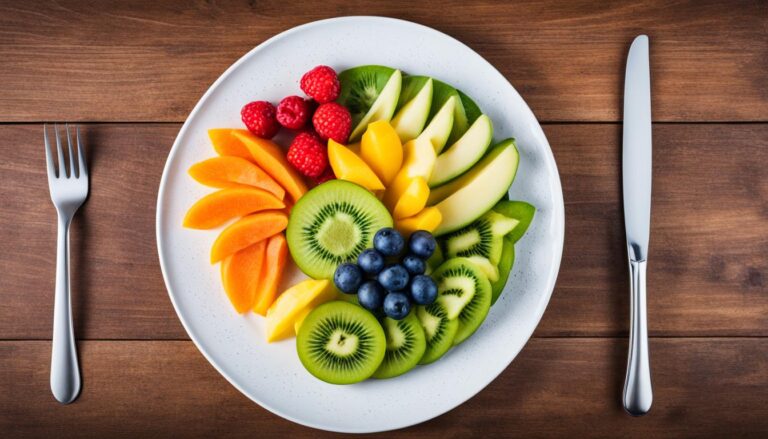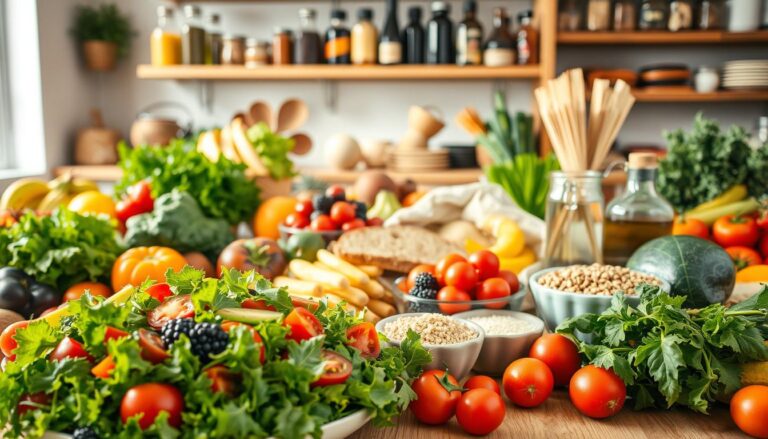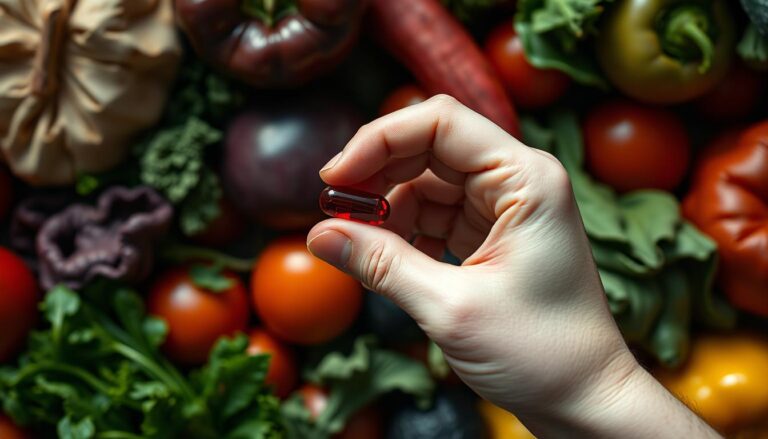Some mornings the meter tells a story I do not want to hear. A small spike a quick dip a mood that follows. If you’ve felt that sway you know how much it shapes your day.
I learned that steadier energy is not about strict rules. It’s about simple smart choices that calm blood glucose levels and keep you moving forward.
This article is about blood sugar control fiber polyphenols and lean protein working together. Think oats with berries coffee with a balanced breakfast or salmon with broccoli. These foods fit a healthy diet and a nutrient rich diet you can enjoy.
They support healthy eating, help with diabetes management, and offer a clear path to better blood sugar control.
Research points to real gains. Polyphenols in berries, apples, tea, and coffee can slow carb breakdown and ease absorption. Fiber from beans lentils, chia, and flaxseed helps tame postmeal spikes.
Lean protein from seafood poultry, eggs, tofu, and lentils adds fullness and steadies your response. Taken together these foods can nudge insulin sensitivity in the right direction and support long term health.
Small changes add up fast. A bowl of oats, a handful of blueberries, a drizzle of extra virgin olive oil or a cup of green tea can be a daily reset. With a few swaps you can build meals that protect blood glucose levels and still taste great. The goal is not perfection it’s a pattern you can keep.
Key Takeaways
- Pair fiber, polyphenols, and lean protein to smooth postmeal blood glucose levels.
- Choose a healthy diet rich in oats, beans berries apples, tea coffee, and olive oil.
- Lean protein supports satiety and aids diabetes management when part of healthy eating.
- Polyphenol rich foods may enhance insulin sensitivity and reduce inflammation.
- Simple meal shifts build a nutrient rich diet you can maintain day after day.
- Consistent patterns matter more than strict rules for blood sugar control.
Why Fiber Polyphenols and Lean Protein Matter for Blood Sugar Control
Steady energy starts with a smart mix of fiber, polyphenols, and lean protein. This trio shapes digestion tempers appetite and supports blood sugar control throughout the day. When built into a healthy diet they help smooth swings in blood glucose levels and promote healthy eating without feeling deprived.
How these nutrients complement each other for glucose homeostasis
Viscous fiber slows gastric emptying and carbohydrate absorption. That curbs sharp rises in blood glucose levels after meals. Polyphenols from berries apples citrus coffee tea cocoa red wine, and olive oil add antioxidant and metabolic support.
Pairing fiber with lean protein further delays digestion and increases satiety. Seafood, poultry, eggs tofu and lentils help keep portions in check as part of healthy eating. Together, these foods back glucose homeostasis while fitting into a balanced, healthy diet.
Links to diabetes management and healthy eating patterns
Soluble fiber from oats, oat bran beans lentils chia, and flaxseed aligns with diabetes care by softening postmeal spikes. Polyphenols complement that effect through gut and cellular pathways that favor blood sugar control.
Lean protein choices including salmon, tuna chicken and soy fit guidance from the American Diabetes Association for regular seafood intake. These habits support weight management goals and a nutrient dense healthy diet that is practical for daily life.
Overview of effects on insulin sensitivity and postmeal blood glucose levels
Higher fiber intakes are linked with better insulin sensitivity and reduced glycemic excursions. Polyphenols may aid signaling pathways that help muscles use glucose more efficiently.
Adding lean protein to meals often moderates postmeal blood glucose levels by slowing absorption and improving fullness. Used together, fiber, polyphenols, and lean protein provide a clear framework for healthy eating that aligns with blood sugar control goals.
Science Snapshot Mechanisms Behind Polyphenols and Glucose Regulation
Research points to how polyphenols influence pathways that shape blood glucose levels. These compounds appear across antioxidant rich foods in a healthy diet and are often discussed in diabetes management because they act at multiple steps from the gut to the cell.

Enzyme inhibition: α-amylase and α-glucosidase to blunt carb digestion
Polyphenols can slow the breakdown of starches by inhibiting α-amylase and α-glucosidase. Berries such as strawberries raspberries blueberries and blackcurrants show activity in vitro. So do beans lentils pumpkin maize and eggplant.
Green tea and black tea, red wine, and black rice also contribute. By reducing early digestion, they help moderate the rise in blood glucose levels after a meal within a healthy diet.
Reduced intestinal absorption via SGLT1 and effects on blood glucose levels
Some polyphenols interfere with SGLT1, the main transporter that moves glucose from the gut into the bloodstream. This can lower the amount absorbed and temper postmeal spikes.
Tea polyphenols and grape derived compounds are notable examples. These effects align with goals in diabetes management that seek steady curves rather than sharp surges.
Cellular actions AMPK activation GLUT4 translocation and insulin signaling
Inside cells, certain compounds such as epicatechin EGCG from green tea, and grape seed procyanidins support AMPK activation. This energy sensor helps the body use glucose more efficiently and may curb liver glucose output.
Blueberry and black soybean extracts have been linked with increased GLUT4 translocation, aiding insulin-mediated uptake. These steps can support insulin signaling pathways that stabilize blood glucose levels in a healthy diet.
Beta cell support antioxidative protection and improved insulin secretion
Antioxidative actions matter for pancreatic beta cells. EGCG and rutin help maintain cellular energy and reduce stress from high glucose. Quercetin, apigenin, and luteolin can dampen NF-κB pathways linked to cytokine injury.
Studies with isolated islets show −epicatechin and quercetin may enhance insulin release. When paired with antioxidant rich foods day to day, these effects align with broader diabetes management strategies.
| Mechanism | Representative Sources | Primary Target | Potential Impact on Blood Glucose Levels |
|---|---|---|---|
| Digestive enzyme inhibition | Blueberries, raspberries, strawberries blackcurrants beans lentils green tea black tea red wine black rice | α-amylase, α-glucosidase | Slower carb breakdown and gentler postmeal rise |
| Reduced intestinal transport | Tea polyphenols grape seed extracts | SGLT1 | Lower glucose absorption from the gut |
| Cellular glucose uptake | EGCG epicatechin grape seed procyanidins blueberry black soybean | AMPK, GLUT4, PI3K signaling | Improved insulin action and tissue uptake |
| Beta cell resilience | EGCG rutin quercetin apigenin luteolin | Oxidative stress NF-κB pathways | Support for insulin secretion under stress |
Dietary Fiber The Backbone of a Low Glycemic Nutrient Rich Diet
Building meals around dietary fiber anchors a nutrient-rich diet and supports healthy eating. Paired with low glycemic index foods, fiber helps pace digestion so energy arrives steadily. This approach fits everyday routines and aligns with diabetes management goals.
Think of fiber as the slow lane for carbs. When the pace eases hunger stays in check and choices feel easier to sustain.
Soluble fiber and resistant starch for lower postmeal spikes
Soluble fiber forms a gentle gel that slows stomach emptying and glucose uptake. Resistant starch travels to the colon where it is fermented into short-chain fats that support insulin signaling.
Together they help blunt postmeal surges, an effect prized in diabetes management and central to healthy eating patterns built on low glycemic index foods.
Top fiber sources oats oat bran beans lentils chia flaxseed
- Oats and oat bran: Rich in beta glucan, which thickens gut contents and tempers glucose release within a nutrient-rich diet.
- Beans and lentils: Combine soluble fiber and resistant starch with protein and magnesium they pair well with rice or tortillas for steadier curves.
- Chia seeds: Absorb liquid to form a gel add to yogurt or smoothies for a slow, even rise in energy.
- Flaxseed: Ground flax blends into oatmeal or whole-wheat batter, adding lignans and fiber that complement low glycemic index foods.
How fiber supports a healthy diet and diabetes management
High fiber meals tend to be more filling, which supports portion control without strict rules. That satiety helps maintain a nutrient-rich diet and encourages steady choices across the day.
When dietary fiber is combined with lean protein and polyphenol-rich produce meals digest more slowly. This pattern aligns with diabetes management and underscores the value of healthy eating that is practical, flavorful, and repeatable.
Evidence Based Polyphenol Foods for Better Blood Glucose Levels
Foods rich in polyphenols can fit into a healthy diet that supports steady energy. These antioxidant-rich foods appear in everyday choices and can aid blood sugar control when woven into healthy eating habits.
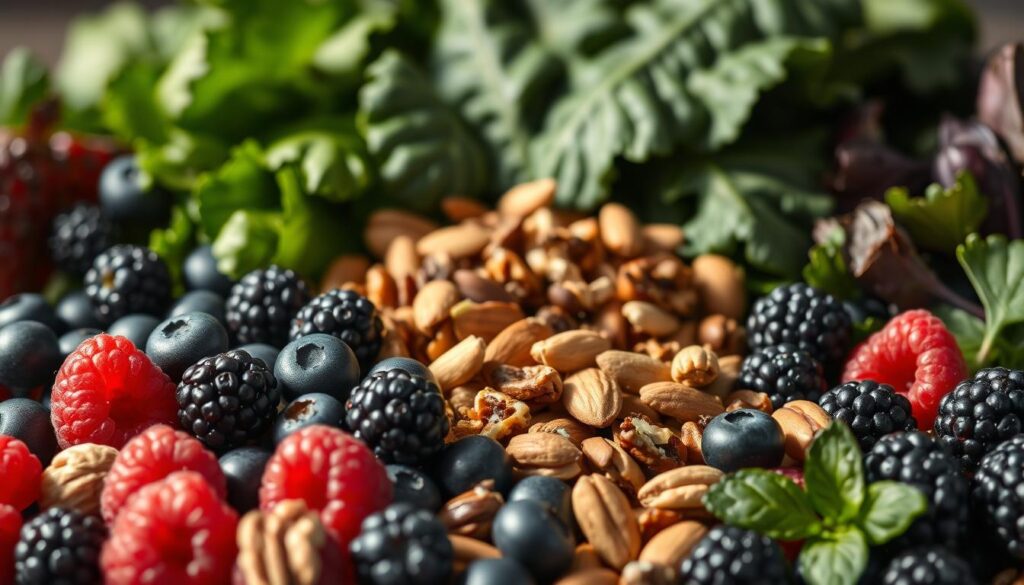
Read more: Managing blood sugar naturally
Berries apples pears and citrus anthocyanins quercetin naringenin
Blueberries, strawberries, and blackberries supply anthocyanins. Regular intake of apples and pears adds quercetin and chlorogenic acid along with fiber. Whole oranges and grapefruits provide naringenin and pith that slow carb release.
Enjoy a cup of mixed berries with plain Greek yogurt. Add a sliced Honeycrisp apple to steel-cut oats. Choose a whole clementine over juice to better align with blood sugar control.
Coffee and tea chlorogenic acids and mixed findings from meta analyses
Freshly brewed coffee offers chlorogenic acids, present in both regular and decaf. Green and black tea bring catechins and theaflavins. Findings differ by dose brew and individual response.
Try coffee without added sugar or syrups. Sip unsweetened green tea with lunch. These choices can complement a healthy diet centered on whole foods.
Cocoa red wine and olive oil antioxidant rich foods and microbiome effects
Natural cocoa powder and high cacao dark chocolate contain flavanols. Moderate red wine intake supplies grape derived polyphenols, while extra-virgin olive oil contributes hydroxytyrosol and oleuropein.
Stir cocoa into warm milk alternatives for a low-sugar treat. Use extra-virgin olive oil from brands like California Olive Ranch for dressings. Keep portions modest and pair with fiber-forward meals to support healthy eating.
Vegetables like broccoli and kale sulforaphane and flavonoids
Broccoli Brussels sprouts, and kale deliver sulforaphane, quercetin, and kaempferol. Light steaming helps preserve these compounds and keeps the veggies crisp.
Serve roasted broccoli with lemon and garlic. Massage kale with olive oil and a squeeze of citrus. These antioxidant-rich foods fit a balanced plate that favors blood sugar control within a healthy diet.
| Food | Key Polyphenols | Simple Use | Why It Helps |
|---|---|---|---|
| Blueberries | Anthocyanins | Top oats or chia pudding | Add color and fiber to support healthy eating and steady glucose |
| Apples | Quercetin, chlorogenic acid | Slice with peanut butter | Pairing with fat slows absorption for blood sugar control |
| Oranges | Naringenin | Eat whole, not juiced | Fiber plus polyphenols supports a healthy diet |
| Coffee | Chlorogenic acids | Brewed, unsweetened | Complements antioxidant-rich foods in daily routines |
| Green tea | Catechins | Hot or iced, no sugar | Light, plant-forward option for healthy eating |
| Cocoa natural | Flavanols | Whisk into warm milk alternatives | Fits dessert swaps while favoring blood sugar control |
| Red wine | Grape polyphenols | Enjoy moderately with meals | Best alongside fiber-rich, antioxidant-rich foods |
| Extra-virgin olive oil | Hydroxytyrosol, oleuropein | Dress salads and roast veggies | Supports a Mediterranean-style healthy diet |
| Broccoli | Sulforaphane | Lightly steamed or roasted | Pairs well with protein for blood sugar control |
| Kale | Quercetin, kaempferol | Massage with olive oil and lemon | Boosts greens in healthy eating plans |
Lean Protein Choices That Support Diabetes Management
Choosing lean protein at each meal can steady appetite and support diabetes management. When paired with fiber and polyphenols, it helps stabilize blood glucose levels and fits a healthy diet. Simple cooking methods also make healthy eating easier to sustain.
Seafood and fatty fish protein plus omega-3s for metabolic health
Salmon, sardines, trout, and mackerel offer lean protein with EPA and DHA. Eating fish at least twice per week aligns with guidance from the American Diabetes Association and supports a healthy diet.
Fatty fish intake around typical weekly portions has been linked with steadier postmeal blood glucose levels compared with lean white fish. Regular seafood intake is also tied to heart benefits, a priority in diabetes management.
Poultry eggs tofu and lentils satiation lower glycemic impact
Skinless chicken and turkey provide complete protein with minimal saturated fat. Eggs deliver high-quality protein research shows one egg per day can improve insulin sensitivity while supporting healthy eating patterns.
Tofu, tempeh, and unsweetened soy milk contribute lean protein and fit plant-forward plans. Lentils add protein plus beta-glucan and resistant starch, which help moderate blood glucose levels after meals.
Protein targets and cooking methods for a healthy eating pattern
Most adults with normal kidney function can aim for 20%–35% of daily calories from lean protein. For a 2,000-calorie plan, that is about 100–175 grams per day. Personalize targets based on age, activity, and kidney status.
Choose baking, roasting grilling or poaching to limit added fat and sodium. Keep sauces simple: olive oil citrus herbs garlic and pepper. Avoid heavy breading and deep frying to support a healthy diet and steady blood glucose levels.
| Protein Source | Typical Serving | Protein g | Notable Nutrients | Glycemic Considerations | Diabetes Management Tips |
|---|---|---|---|---|---|
| Salmon fatty fish | 4 oz cooked | 23 | EPA/DHA, vitamin D, selenium | Zero carbs supports stable blood glucose levels | Enjoy 2+ times weekly grill or roast with lemon and herbs |
| Sardines | 1 can 3.75 oz | 22 | EPA/DHA, calcium with bones B12 | Minimal carbs satiating lean protein | Choose in water or olive oil pair with leafy greens |
| Chicken breast skinless | 4 oz cooked | 26 | Niacin, B6, selenium | Very low carbs steady energy for healthy eating | Bake or poach season with spices instead of salty rubs |
| Eggs | 2 large | 12 | Choline, lutein, B12 | Low carbs supports satiety and blood glucose levels | Boil or scramble in a nonstick pan add vegetables |
| Tofu firm | 4 oz | 10 | Calcium fortified iron, isoflavones | Low carbs gentle on postmeal rise | Stir-fry with broccoli and mushrooms use low-sodium tamari |
| Lentils cooked | 1 cup | 18 | Beta glucan fiber, folate, potassium | Low glycemic blunts postmeal spikes | Simmer with tomatoes and kale portion 1 cup with vegetables |
Blood sugar control fiber polyphenols and lean protein
Blood sugar control fiber polyphenols and lean protein work best as a team. Fiber from oats, beans lentils chia, and flaxseed slows carb absorption steadies blood glucose levels, and supports a healthy diet with steady energy.
Polyphenol-rich foods like berries, apples, citrus coffee, tea, cocoa, red wine, olive oil, broccoli, and kale act on enzymes and transporters that influence glucose handling. Lean protein from salmon, tuna chicken eggs tofu, and lentils helps curb appetite and smooth postmeal swings that matter for diabetes management.
In daily meals, pair soluble fiber with colorful produce and a modest portion of lean protein. This simple pattern can help temper postmeal blood glucose levels while fitting a healthy diet people can keep.
Keep cooking methods light grill bake poach or steam to retain polyphenols and preserve protein quality without excess sugars.
Choose practical swaps: oat bran at breakfast with blueberries a lentil and kale bowl at lunch with extra-virgin olive oil or grilled salmon at dinner with broccoli and a citrus side.
These choices reflect what many shoppers can find at Whole Foods Market, Trader Joe’s, Kroger or local farmers’ markets, and they align with everyday diabetes management goals.
Note the balance: fiber to slow digestion, polyphenols to support cellular pathways, and lean protein to increase satiety. Together, they shape meals that are flavorful flexible, and mindful of blood glucose levels across the day.
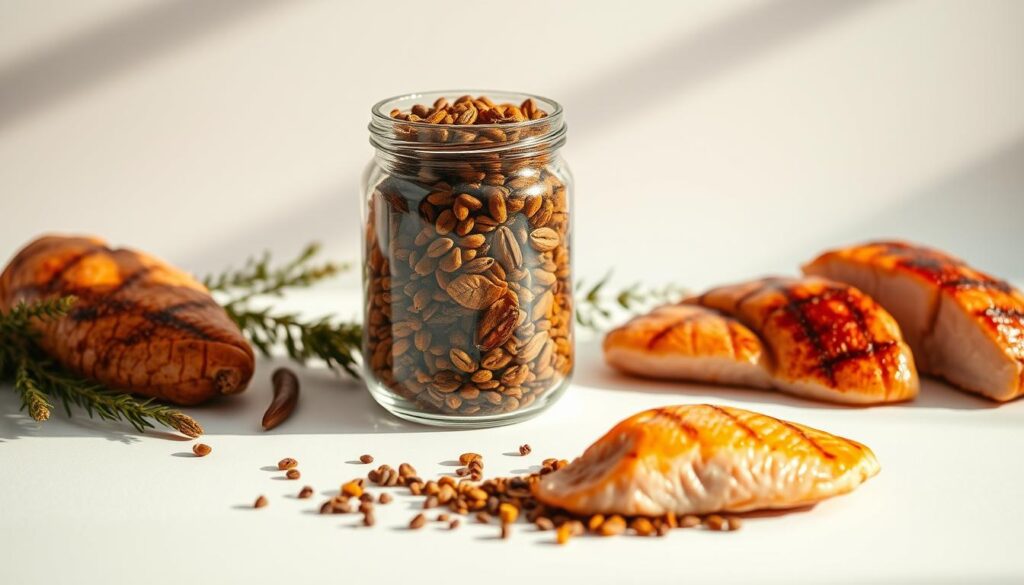
Read more: 10 Healthy Foods Fruits Legumes Fiber amp Protein
Smart Meal Building Low Glycemic Index Foods and Balanced Plates
Build each plate around low glycemic index foods to support steady energy and blood sugar control. Keep meals simple, colorful, and rich in plants. This approach fits healthy eating goals while delivering a nutrient-rich diet you can sustain.
Combine fiber + polyphenols + lean protein to slow glucose absorption
Pair soluble fiber and resistant starch with polyphenol-rich produce and a lean protein. This trio thickens the meal’s matrix, slows carbohydrate breakdown, and helps blood sugar control. It also aligns with healthy eating and a nutrient-rich diet.
- Fiber: oats oat bran beans lentils chia, and flaxseed.
- Polyphenols: berries apples citrus broccoli kale, extra virgin olive oil coffee and tea.
- Lean protein: salmon sardines poultry tofu eggs, and strained yogurt.
Example pairings oats with berries lentil chickpea bowls with kale salmon with broccoli
For breakfast, choose oatmeal or oat bran topped with blueberries and strawberries. Add ground flaxseed for extra soluble fiber and omega-3s.
For lunch, build a warm lentil–chickpea bowl with kale and extra-virgin olive oil. Season with lemon and herbs. Keep the base mostly nonstarchy vegetables.
For dinner, serve baked salmon or sardines with lightly steamed broccoli. Sprinkle a pinch of mustard seed powder to support myrosinase activity. Add a side of chia flax mix for texture and fiber.
Helpful add-ons include a small apple or orange before meals to blunt spikes, and coffee or tea without added sugars for chlorogenic acids. If choosing red wine weigh personal health risks and alcohol’s effects.
Portion guidance for stable blood sugar and a nutrient rich diet
- Fill half the plate with nonstarchy vegetables for volume and low glycemic index foods.
- Include 20–35 g of protein per meal, aiming for 20%–35% of daily calories.
- Target 8–10 g of soluble fiber per meal from oats, pulses, chia, and flaxseed.
- Use baking, roasting, grilling, or poaching. Limit refined carbs and added sugars to keep glycemic load in check.
| Meal Idea | Core Ingredients | Polyphenol Source | Protein approx. | Soluble Resistant Fiber approx. | Cooking Notes |
|---|---|---|---|---|---|
| Oatmeal with Berries | Oat bran, blueberries, strawberries, ground flaxseed | Anthocyanins from berries | 15–20 g add Greek yogurt or eggs to reach 25–30 g | 6–8 g from oats + 2–3 g from flaxseed | Simmer oats avoid added sugars finish with cinnamon |
| Lentil Chickpea Bowl with Kale | Cooked lentils, chickpeas kale extra-virgin olive oil, lemon | Quercetin and kaempferol from kale | 20–25 g from pulses add tofu to reach 30–35 g | 8–10 g from lentils and chickpeas | Roast or simmer season with herbs keep portions veggie-forward |
| Salmon with Broccoli | Baked salmon, steamed broccoli mustard seed powder chia–flax side | Sulforaphane from broccoli | 25–35 g from salmon | 4–6 g from chia–flax mix | Bake or grill fish lightly steam broccoli add mustard for myrosinase |
| Yogurt or Kefir Parfait | Plain Greek yogurt or kefir strawberries ground flaxseed | Anthocyanins from strawberries | 20–25 g from dairy add nuts to reach 30 g | 3–5 g from flaxseed | Choose unsweetened dairy chill and serve with a squeeze of lemon |
| Premeal Fruit Strategy | Apple or orange unsweetened coffee or tea | Flavonoids chlorogenic acids from coffee | 0–2 g pair with a protein snack if needed | 2–4 g from fruit | Drink coffee or tea without sugar time fruit 10–15 minutes premeal |
Gut Health Matters Polyphenols Probiotics and Metabolic Benefits
A thriving gut shapes how the body handles glucose. Most polyphenols travel to the colon, where microbes transform them into active metabolites that support a healthy diet and healthy eating. This microbiome shift aligns with better diabetes management and steady energy.
Polyphenol driven increases in Bifidobacteria and Lactobacillus
Cocoa flavanols, wild blueberry powder, grape seed proanthocyanidins, and red wine polyphenols are antioxidant-rich foods linked with higher Bifidobacterium and Lactobacillus.
These changes track with lower inflammatory markers and improved cholesterol profiles in controlled and observational research.
Greater Bifidobacteria often coincides with better glucose tolerance and fewer cytokines such as IL-6 and TNF-α. For a healthy diet, rotate berries, dark chocolate with high cacao content, extra-virgin olive oil, and grapes to sustain microbial diversity.
Fermented foods kefir yogurt kimchi sauerkraut and insulin sensitivity
Probiotic foods add living cultures that complement polyphenols. Kefir used daily has lowered fasting glucose and HbA1c versus non-probiotic versions in people with type 2 diabetes. Plain yogurt intake in large cohorts links to a lower risk of type 2 diabetes.
Kimchi and sauerkraut contribute beneficial microbes, minerals, and acids that fit into healthy eating. Pair these with antioxidant-rich foods to build meals that aid diabetes management without excess sugar or refined starch.
Inflammation reduction CRP and implications for glucose control
Microbiome shifts from polyphenols often align with lower C-reactive protein. Patterns that include cocoa, berries, and red wine in moderation show CRP declines that track with Lactobacillus gains.
Lower CRP supports insulin action and steadier postmeal responses. In a healthy diet, combine high-fiber plants, lean protein, and polyphenols to reinforce gut balance alongside probiotic choices.
- Tip: Aim for a colorful mix of berries apples citrus and greens include kefir or plain yogurt and use extra-virgin olive oil to unite polyphenols and probiotics
- Choose unsweetened options to keep carbohydrate loads modest for diabetes management.
- Consistent intake matters more than single servings build small repeatable habits.
Conclusion
Bringing fiber, polyphenols, and lean protein together creates a clear path to better blood sugar control. These nutrients work on several fronts they slow carbohydrate digestion temper absorption and improve insulin signaling and GLUT4 activity.
They also help curb liver glucose output protect beta cells from oxidative stress, and support a healthier gut with lower CRP. This integrated approach fits a nutrient-rich diet that supports diabetes management across daily life in the United States.
Evidence favors high-fiber staples like oats or oat bran, beans, lentils, chia, and flaxseed, along with polyphenol-rich foods such as berries, apples, pears, citrus, coffee, tea, cocoa extra virgin olive oil broccoli and kale.
Lean protein from seafood fatty fish poultry eggs, tofu and lentils anchors meals with steady fullness and a lower glycemic impact. While observational data and controlled studies show gains in postmeal blood glucose, insulin sensitivity, and HbA1c, some findings are mixed and call for more rigorous trials.
In practice, build balanced plates from low glycemic index foods and keep protein near 20%–35% of energy when appropriate. Choose minimally processed items and use low fat cooking methods like baking grilling, or steaming. Add fermented foods such as yogurt, kefir, kimchi, or sauerkraut to enhance microbiome-driven benefits.
This simple pattern pairing fiber, polyphenols, and lean protein delivers sustainable blood sugar control within a nutrient-rich diet and aligns with modern diabetes management goals.

